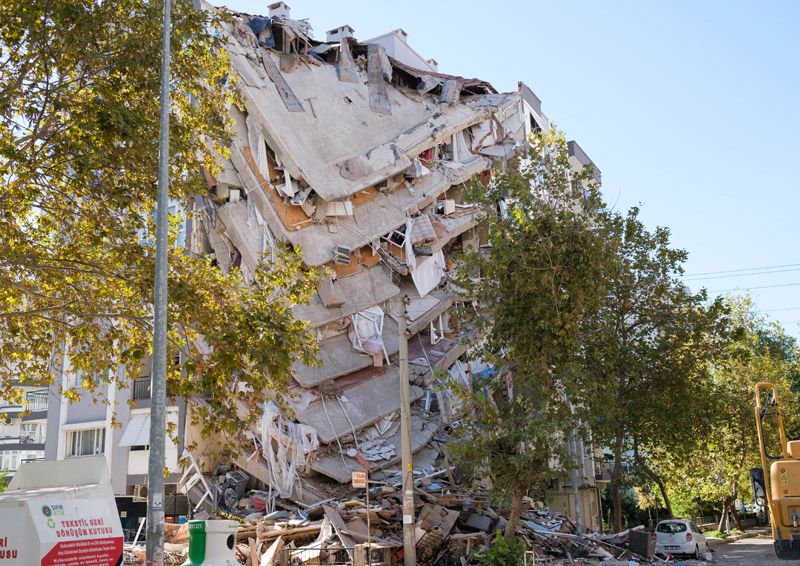Damian Grant, author of Earthquake Design Practice for Buildings, Fourth edition shares his insights on designing earthquake-resistant buildings in seismic areas around the world.

- Updated: 08 Dec 2020
- Author: Damian Grant, Associate Director, Arup
On 30 October 2020, a magnitude 7.0 earthquake struck the Aegean Sea near the Greek island of Samos, off the east coast of Turkey. You may still recall the news images of collapsed buildings and reports of hundreds of deaths, particularly in the Turkish city of İzmir. The short attention span of the news cycle moves on, the search and rescue phase concludes and the world's focus shifts to other catastrophes and existential threats. Meanwhile, those living in afflicted areas will spend the next months or years recovering from the disaster. In times of unrestricted international travel, it’s about this time, a month or so after a major, damaging earthquake, that seismic engineers gather into reconnaissance teams, and travel to the affected area to collect data and lessons learnt for the global engineering community.
In truth, preventing building collapses and loss of life in earthquakes is largely a solved problem, at least technically. Modern seismic design follows a ‘capacity design’ philosophy, first developed in New Zealand in the 1970s and subsequently adopted in building codes around the world. Capacity design involves the careful detailing of specific locations on a building to allow controlled crushing of concrete or plastic yielding of steel without fracture. Meanwhile, other structural components are over-designed by enough of a margin that they are very unlikely to fail – even if an earthquake jolt is much larger than expected.
Plastic zones in a capacity-designed building are often compared to fuses in an electrical circuit, which sacrifice themselves to prevent excessive current in other components of the circuit. The analogy is not perfect. Structural ‘fuses’ can save buildings from collapse and prevent loss of lives, but they are generally not as easy to replace as electrical ones. A big lesson from the Canterbury earthquake sequence that struck New Zealand in 2010–2011 was that ‘as intended’ seismic performance of buildings meant the safe evacuation of occupants, but also heavy damage that was impossible or uneconomical to repair after the earthquakes. The result was extensive demolition and rebuild of buildings in central Christchurch, resulting in the dislocation of business, commerce and tourism from the heart of the city.
The Canterbury earthquakes gave a fresh focus to efforts in the seismic community aimed at understanding building performance better and targeting ‘functional recovery’ for important buildings following a major earthquake. Life safety of building occupants is necessary but is not sufficient. Key components of the new paradigm of earthquake engineering are:
- Analytical software, accessible to engineers in a design office environment, able to accurately assess engineering response parameters such as building drifts and accelerations.
- 'Performance-based earthquake engineering’ frameworks that relate these engineering metrics to more relatable measures of building performance such as expected repair times and costs.
- Technological solutions to offer improved performance without a disproportionate initial cost premium.
Improved performance can mean changing the dynamic properties of the structure so that it is less affected by an earthquake shaking. An example of this is seismic isolation, which detunes the vibration response of a building from predominant earthquake frequencies, and concentrates seismic movements in an engineered device, well-tested in the laboratory before installation on site. An alternative to avoiding damage is to control it. An example of a technology applied in the Christchurch rebuild is ‘replaceable plastic hinges’, which takes the ‘structural fuse’ analogy to its fullest extent, by deliberately concentrating damage in a component that can be readily replaced after an earthquake.
As author William Gibson said, “the future is already here – it's just not evenly distributed.” In the context of seismic-resistant buildings, this can be interpreted in a few ways. Firstly, whilst engineers may have the earthquake problem somewhat under control for new building design, most of the world’s building stock was built before modern seismic codes. Engineers involved in seismic assessment and retrofit of existing buildings of course have a similarly well-equipped toolkit to draw from. Convincing building owners of the benefit of often-expensive retrofits can be difficult, however, particularly if the last major earthquake struck decades or even generations ago.
Secondly, effective seismic-resistant design comes at a small premium, in terms of costs and engineering resource. Purely in terms of material costs, seismic protective technologies can add say 5–10% to construction costs (although the actual number is very building and system-dependent). It requires specialist engineers and contractors to employ both the methods and technologies of the modern earthquake engineer’s toolkit. It requires scruples. Why put the extra rebar in the concrete joint if you can get away with leaving it out? Indeed, the late Nick Ambraseys and Roger Bilham concluded in a Nature article in 2011 that ‘Corruption Kills’ – a disproportionate number of earthquake fatalities in the previous 30 years had occurred in ‘anomalously corrupt’ countries.
Nevertheless, earthquake engineering is in an exciting time. As that eminently quotable Winston said, “We have the tools, and we have the talent.” (that’s Winston Zeddemore, Ghostbusters). Now we just have to deploy these tools and talents in the service of resilient and joyful building design in the world’s seismic hotspots.
My new book, Earthquake Design Practice for Buildings, Fourth edition, available as a print book and an eBook, includes extensive coverage of the principles and design rules that are used to design earthquake-resistant buildings in seismic areas of the world. Get practical and easy to read advice on the technical issues that have to be considered in the seismic design of buildings.
